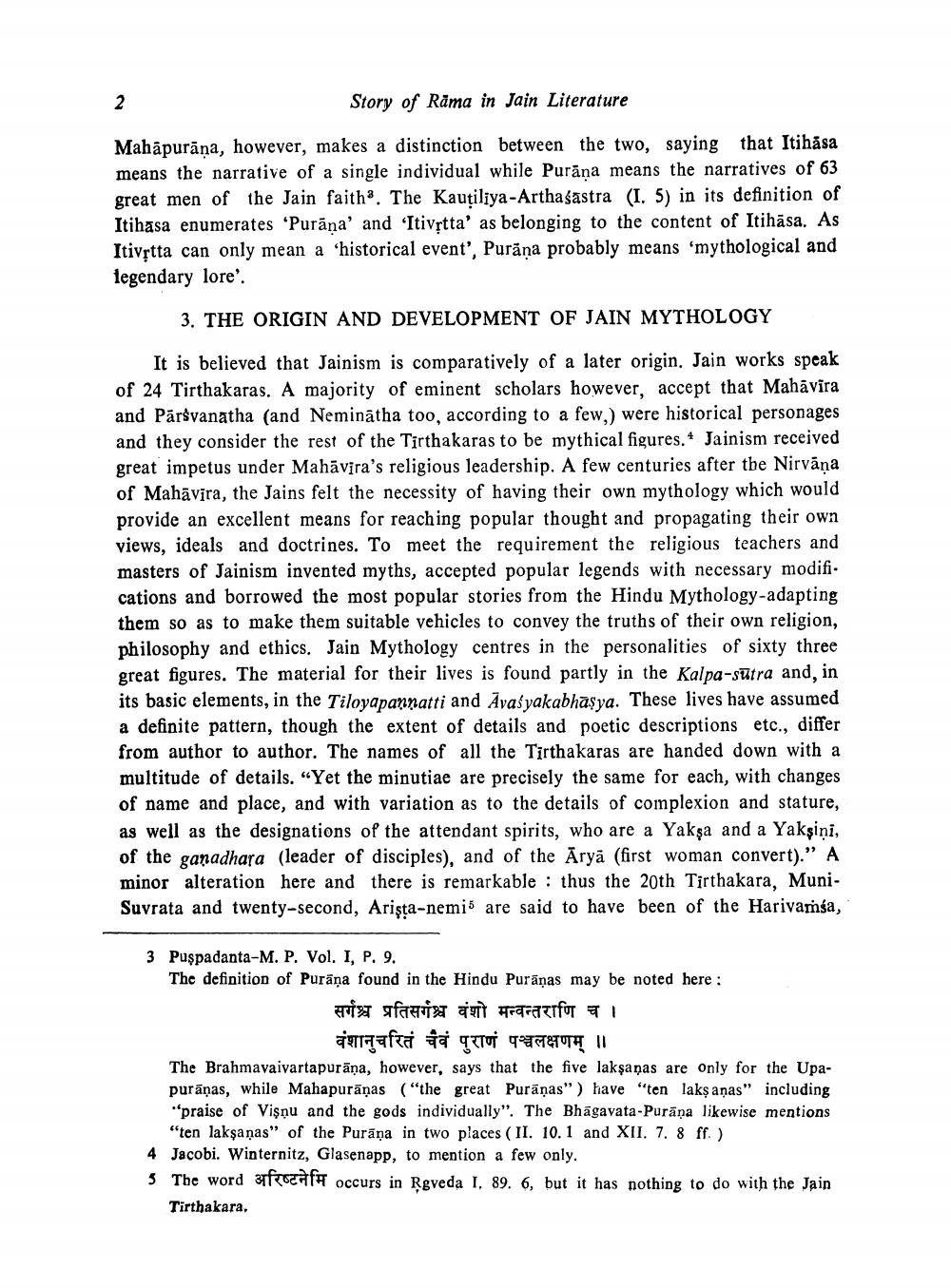________________
Story of Räma in Jain Literature
Mahāpurāņa, however, makes a distinction between the two, saying that Itihasa means the narrative of a single individual while Purāņa means the narratives of 63 great men of the Jain faith. The Kauțiliya-Arthasastra (I. 5) in its definition of Itihasa enumerates 'Purāņa' and 'Itivștta' as belonging to the content of Itihāsa. As Itivștta can only mean a “historical event', Purāņa probably means 'mythological and legendary lore'.
3. THE ORIGIN AND DEVELOPMENT OF JAIN MYTHOLOGY
It is believed that Jainism is comparatively of a later origin. Jain works speak of 24 Tirthakaras. A majority of eminent scholars however, accept that Mahavira and Pārsvanatha (and Neminātha too, according to a few,) were historical personages and they consider the rest of the Tirthakaras to be mythical figures. 4 Jainism received great impetus under Mahāvira's religious leadership. A few centuries after the Nirvāņa of Mahāvira, the Jains felt the necessity of having their own mythology which would provide an excellent means for reaching popular thought and propagating their own views, ideals and doctrines. To meet the requirement the religious teachers and masters of Jainism invented myths, accepted popular legends with necessary modifi. cations and borrowed the most popular stories from the Hindu Mythology-adapting them so as to make them suitable vehicles to convey the truths of their own religion, philosophy and ethics. Jain Mythology centres in the personalities of sixty three great figures. The material for their lives is found partly in the Kalpa-sūtra and, in its basic elements, in the Tiloyapannatti and Avaš yakabhașya. These lives have assumed a definite pattern, though the extent of details and poetic descriptions etc., differ from author to author. The names of all the Tirthakaras are handed down with a multitude of details. "Yet the minutiae are precisely the same for each, with changes of name and place, and with variation as to the details of complexion and stature, as well as the designations of the attendant spirits, who are a Yakşa and a Yakşini, of the ganadhara (leader of disciples), and of the Arya (first woman convert)." A minor alteration here and there is remarkable : thus the 20th Tirthakara, MuniSuvrata and twenty-second, Arişta-nemis are said to have been of the Harivamsa,
3 Puşpadanta-M. P. Vol. I, P. 9. The definition of Purāņa found in the Hindu Purānas may be noted here :
सर्गश्च प्रतिसर्गश्च वंशो मन्वन्तराणि च ।।
वंशानुचरितं चैवं पुराणं पञ्चलक्षणम् ॥ The Brahmavaivartapurāņa, however, says that the five laksaņas are only for the Upapurāņas, while Mahapuräņas ("the great Purāņas") have "ten lakşaņas" including "praise of Vişnu and the gods individually". The Bhāgavata-Purāņa likewise mentions
"ten laksanas" of the Purāna in two places (II. 10.1 and XII. 7. 8 ff.) 4 Jacobi. Winternitz, Glasenapp, to mention a few only. 5 The word 3faf occurs in Rgveda I. 89. 6, but it has nothing to do with the Jain
Tirthakara,




